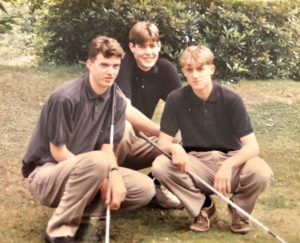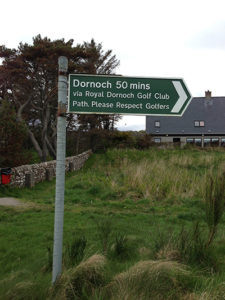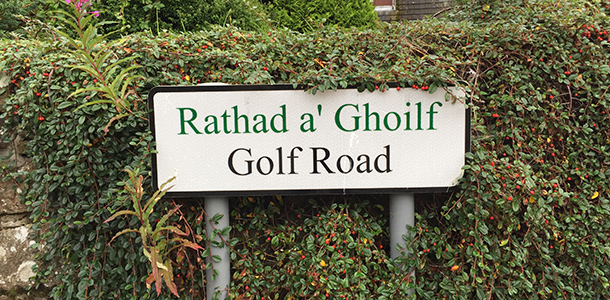What I Did For Love (of the Game) – A Fleeting Visit to Dornoch
by Tony Dear
Sometimes, what we do in life just makes no sense. And our only excuse at the time (and even years later) was that we just had to do it, that there was no way we could not do it.
We’ve gone to great lengths to play this great game. Solo, buddy trips, group travel; in the light of day, the dark of night, at dawn and at dusk.
It makes no sense. And we keep doing it. (Done anything crazy in your life just to play this game? Send your tale to editor@thepnga.org.)
Though he’d never been there, my dad often spoke of Royal Dornoch – this magical, mystical links in the far north of Scotland where golf of some form had been played for nearly 400 years, where nine rudimentary holes had been laid out in 1877, and where Old Tom Morris had created something altogether superior and more enduring in 1886.
We’d been to St. Andrews and played the Old Course plus a number of Scotland’s other great venues during our annual summer golf trips to the Open Championship, but Carnoustie was as far north as Dad and I had been.

We lived a world away in the far south of England (532 miles according to Google Maps, but it felt like a different planet). Anything north of Dundee just seemed like heading above the Arctic Circle into the great unknown.
I pictured a dark, cruel landscape inhabited by hostile clans whose members wore long kilts and grew longer beards; a place where people spoke some strange Gaelic/Scots/Scandinavian mix that only fellow Highlanders could hope to understand, and where blood sausage and whale blubber were culinary staples.
Of course, I’d let my imagination run wild, rather. Back then, we may not have had websites, social media, or much immediate access to information about the place, but I did have a copy of the 1986 version of the World Atlas of Golf which spoke very highly of Royal Dornoch.
And I knew that Ben Crenshaw had flown home only reluctantly after visiting the former Royal Burgh and playing the course in 1980. It was also well-known that Tom Watson had been utterly captivated when he first went in 1981. That was more than enough – I knew that someday I would have to go there myself.

The chance came in November 1991. It would need to be an absurdly swift visit, hastily-arranged and executed with precision if it was to work, but I was too eager to try it to deny myself. It wasn’t a case of “now or never” – I was only 20 and there would surely be other opportunities down the road – but youth’s unchecked impulses would win the day.
I’d been working as an apprentice PGA professional at a club an hour’s drive south of London for about six months and, besides Sundays, hadn’t had a single day off. During summer and early autumn, six-day/72-hour weeks had been the norm, and only as winter approached did business in the pro shop start to slow and the boss take his foot off the pedal.
In a rare moment of magnanimity, he gave me two days off which, when added to that precious recurring Sunday, meant three straight days in which to relax.
But there would be no relaxing.
On Sunday morning, I threw my golf clubs, a couple of golf shirts, trousers, underwear, and raingear into the trunk of the car, and headed north. Five hours later, I rolled into Liverpool where I’d been a member of the university golf team whose home matches were played at Hoylake (guess where I spent most of my time as an undergraduate). Friends from college days were still around, so we headed to the Student Union bar for an evening of really cheap beer.
An early start Monday morning would see me arrive in Dornoch, still 420 miles away, in time for dinner. It would mean having to bypass Ayrshire and Fife on the M74, M80, and A9 but the pot of gold waiting at the end allayed disappointment, and kept anticipation running high.

I merged on to the A9 in the fading sunlight of late afternoon, making the drive from Perth to Killiecrankie, then Aviemore and Inverness impossibly scenic – the route through the western Cairngorms is a world top-5 drive, no question.
It was dark and yes, a little stormy, as I turned on to the A949 for Dornoch at around 8pm. I’d not had the foresight to book any lodging (pre-internet days, remember – not so easy to book accommodation) so drove slowly looking for any hint of an available bed for the night.
Not only did the internet not exist, the golf travel boom hadn’t really happened yet either, so there were no signs paving the way for ill-prepared golf tourists. I didn’t know how or where I was going to sleep in this sleepy little town.
A couple of establishments – the Eagle Hotel and Dornoch Castle – on Castle St. looked well out of my price range, but there was a room at a reasonably-priced B&B on Mackay Road.
The family that owned it were just sitting down to dinner as I arrived, and they asked me to join them, an invitation I gratefully accepted after 10 hours on the road.
Tuesday was my last day of freedom, so it would need to start early. November mornings in northern Scotland are cold and cloudy, however, and don’t really begin until 8am, so there would be no cockcrow, first-light golf and getting all 18 in by breakfast.
Luckily, the pro was already in his shop at 7:30am and, because there was no frost that morning, he happily sent me out as a single, generously giving me the PGA rate (about £5 – less than $10).
The first couple of holes were completed in near darkness, but by the third, the sun was emerging from behind the frigid-looking North Sea. The previous evening’s wind and rain had moved on, and the course was soon lit by a glorious, wintry sun that certainly wasn’t emitting any heat but had risen far enough above the horizon to illuminate the fairways and create deep shadows around the bunkers and dunes.
This was nearly 30 years ago, but I remember the scene vividly.
Royal Dornoch was everything I expected – enthralling, enchanting, endlessly entertaining. Every hole had its own bit of magic. It was very challenging in places – the 14th, “Foxy,” is a remarkably difficult hole; but soft in others – the Par 3s, though far from easy, are just plain fun. It is definitely one of those courses you immediately want to take on again after holing out on the 18th.
But I couldn’t. I’d finished in two hours, but needed to get on the road. My next round here would have to wait (a couple of years actually, when a Scottish pal got married in the Dornoch Castle), so after a quick bacon butty and swig of tea in the clubhouse, I was driving south.

Not far though. Seventy miles into the journey, a sign for Boat of Garten flashed by. Though little-known outside of Scotland, I was aware of the James Braid-designed Boat of Garten GC and had heard it was a terrific little course. After a few quick calculations, however – 580 miles to go with traffic aggravated by Glasgow, Liverpool, Birmingham, and London – it was clear I’d never be able to play it and get home before midnight.
What the heck. I couldn’t resist and took the exit thinking this opportunity might never reappear.
With no one about, I put £5 in the honesty box and was round in less time than I’d taken at Royal Dornoch. No visit to the pro shop or clubhouse, I was there and gone in 90 minutes. I didn’t quite run, just walked fairly briskly and played a single ball.
‘The Boat’ is a quiet sort of a club that never gets the recognition and adoration other Scottish courses do – fair enough, considering how good those other Scottish courses are. But I guarantee you’ll be happy you squeezed it into your itinerary.
I’d played 36 holes at two different courses 70 miles apart before 1pm, but now faced the 12-hour drive back home. After making it into my bed around 3am, I was back in the pro shop at work by 8am.

The boss asked if I’d enjoyed my time off. “Nice to get away from golf for a couple of days, eh?” he said.
“Right,” I smiled.
Tony Dear is an award-winning golf writer who has authored several books on golf, including the recent “The Story of Golf in Fifty Holes.” His work can be found in the world’s top golf publications.
(This article previously appeared in the February 2020 issue of Pacific Northwest Golfer magazine.)






